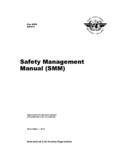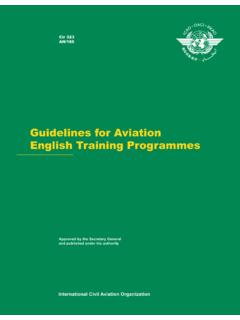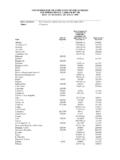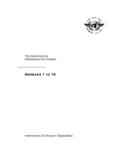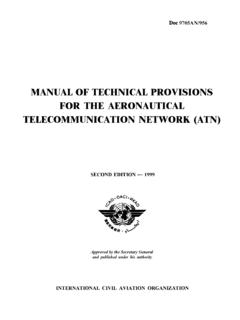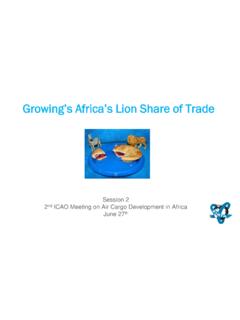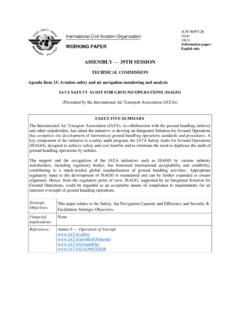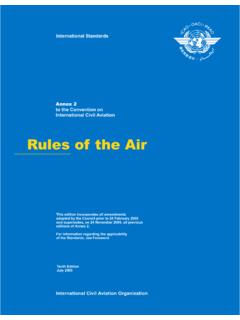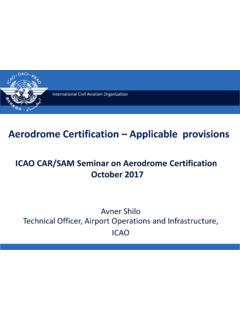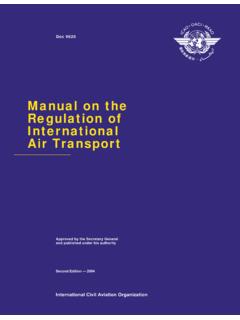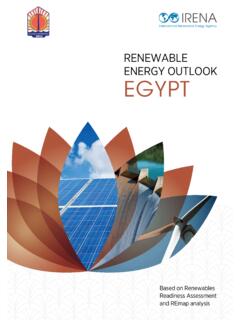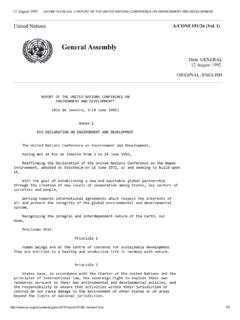Transcription of Sustainable Aviation Fuels Guide 090418 - ICAO
1 Sustainable AVIATIONFUELS GUIDETRANSFORMING GLOBAL Aviation COLLECTION4 OF 4 ICAO 2017. All rights reserved. This report was produced within the framework of the joint ICAO-UNDP-GEF assistance project Transforming the Global Aviation Sector: Emissions Reductions from International Aviation . The views expressed in this publication do not necessarily represent the individual or collective opinions or official positions of these organizations or their Member States. The designations employed and the presentation of the material in this publication do not imply the expression of any opinion concerning the legal status of any country, territory, city or area or of its authorities, or concerning the delimitation of its frontiers or boundaries.
2 Dotted and dashed lines on maps represent approximate border lines for which there may not yet be full agreement. The mention of specific companies or products does not imply endorsement in preference to others of a similar nature that are not mentioned. All reasonable precautions have been taken to verify the information contained in this publication. However, the material is published without warranties of any kind, either expressed or implied, as to the accuracy, completeness and currency of the information. ICAO and its partners expressly disclaim all liability arising in connection with any interpretation or use of the material in this report. ii PREFACE The International Civil Aviation Organization (ICAO) and its Member States are working together to develop State Action Plans to reduce CO2 emissions from international Aviation .
3 The development and completion of States Action Plans on CO2 Emissions Reduction Activities from International Aviation requires the establishment of a structured cooperation process amongst national Aviation stakeholders, which aims to provide the State authority with the information it needs to set-up a long-term strategy for the mitigation of international Aviation CO2 emissions. The voluntary submission of an action plan to ICAO provides the opportunity for States to showcase policies and actions, including tailor-made measures that are selected on the basis of their respective national capacities and circumstances. Many Member States, particularly Developing States and Small Island Developing States (SIDS), continue to investigate the institutional and financial resources necessary to develop and implement their action plans, and the actions therein.
4 For example, many States, through their civil Aviation authorities, are beginning to integrate environmental programmes into their planning and development , and these need to be coordinated with other government agencies. Some States also endeavour to establish or improve the national regulatory and policy frameworks necessary to encourage low carbon technology deployment, which is critical to stimulating private sector market activity. Others would also like to benefit from low carbon technologies that are being successfully developed in other parts of the world. This means that the State Action Plan initiative can be key to States developing coordinated activities aimed at reducing CO2 emissions from international civil Aviation .
5 ICAO has developed Doc 9988, Guidance on the development of States Action Plans on CO2 Emissions Reduction Activities, which aims to support Member States as they develop and implement their Action Plans. As of January 2018, 106 States representing more than per cent of global revenue tonne kilometres (RTK) have voluntarily submitted their Action Plans to ICAO. Doc 9988 presents the basket of measures that Member States can consider for reducing CO2 emissions from civil Aviation . One important opportunity for ICAO Member States to achieve their environmental and carbon emissions reduction objectives is through the use of Sustainable Aviation Fuels (SAF).
6 The purpose of this guidance is to inform ICAO Member States on how Sustainable Aviation Fuels can be deployed to reduce CO2 emissions from international Aviation activities, and describes fuel production pathways, usage constraints, environmental and other benefits, and policy perspectives on the use and development of these Fuels . Together with guidance documents on Renewable energy for Aviation , Financing Aviation Emissions Reductions, and Regulatory and Organizational Framework to address Aviation Emissions, this guidance on Sustainable Aviation Fuels will contribute to ICAO s comprehensive approach to support its Member States in the implementation of their Action Plans in order to address CO2 emissions from international civil Aviation .
7 Iii LIST OF ACRONYMS AND SYMBOLS AFTF Alternative Fuels Task Force ASA Aeropuertos y Servicos Servicios Auxiliares ATJ Alcohol-to-Jet BC Biochemical Conversion BEFS Bioenergy and Food Security CAEP Committee on Aviation Environmental Protection CAF Conventional Aviation Fuel CAAFCER Canada s Civil Aviation Alternate Fuel Contrail and Emissions Research project CAAFI Commercial Aviation Alternative Fuels Initiative CARB California Air Resource Board CBSCI Canada s Biojet Supply Chain Initiative CORSIA Carbon Offsetting and Reduction Scheme for International Aviation CO2 Carbon Dioxide dLUC Direct Land Use Change DOE Department of energy DSHC Direct Sugar to Hydrocarbons EU European Union EU RED European Union Renewable energy Directive EU-ETS European Union Emission Trading Scheme FAA Federal Aviation Administration FAO United Nations Food and Agriculture Organization FT Fischer-Tropsch GBEP Global Bioenergy Partnership GEF Global Environment Facility GFAAF Global Framework for Aviation Alternative Fuels Gha Giga hectare GHG Greenhouse Gas ha Hectare HEFA Hydroprocessed Esters and Fatty Acids HFS Hydroprocessed Fermented Sugars HTL Hydrothermal Liquefaction IATA International Air Transport Association ICAO International Civil Aviation Organization IEA International energy Agency iLUC Indirect Land Use Change IPCC Intergovernmental Panel on Climate Change IRENA
8 International Renewable energy Agency ISCC International Sustainability & Carbon Certification ISO International Organization for Standardization LCA Life Cycle Assessment LCFS Low Carbon Fuel Standard LUC Land Use Change MBM Market Based Measures ML Megalitre MSW Municipal Solid Waste NISA Nordic Initiative for Sustainable Aviation RFS Renewable Fuel Standard RINs Renewable Identification Numbers RSB Roundtable on Sustainable Biomaterials RTK Revenue Tonne Kilometre SAF Sustainable Aviation Fuels SARPs Standards and Recommended Practices SCOPE Scientific Committee on Problems of the Environment SDGs UN Sustainable development Goals SIDS Small Island Developing States SIP Synthetic Iso-paraffin SPK Synthesized Paraffinic Kerosene UCO Used Cooking Oil UNDP United National development Programme WWF World Wildlife Fund iv CONTENTS List of Acronyms and Symbols iii!
9 Contents iv!Figures v!Tables v!Background 1! !Introduction 3! !The work of ICAO on Environmental impacts and Climate Change 3! !The work of ICAO on Sustainable Aviation Fuels 4! !The work of ICAO on a Global Market-Based Measure 6! ! Sustainable Aviation Fuels 8! !The growing interest in SAF 8! !The essential drop-in concept 9! !Emissions reductions from SAF 10! !Drivers to develop SAF 10! !Conditions for promoting SAF 12! !Stakeholders roles and responsibilities 12!A. Government institutions 12!B. Airlines 13!C. Aviation equipment manufacturers 14!D. Fuel producers 15!E. Aviation fuel distributors 15! !National conditions to develop a SAF market 15!A. Legal and regulatory framework 15!
10 B. Infrastructure 16!C. Agriculture potential for feedstock production 17!D. Residues and wastes as feedstock 20! !How to produce SAF 22! !Approved conversion processes 23! !Feedstock options 24! Sugar/starch feedstocks 24! Oil feedstocks 24! Lignocellulosic feedstocks 26! !Processing routes 28! !Lipids conversion 28! !Thermochemical conversion 29! !Biochemical conversion 30! !Sustainability of Aviation Fuels 30! !Environmental issues 30! !Socioeconomic issues 32! !Schemes for sustainability certification 32! !How to promote the use of SAF 35! !Economic considerations 35! !Supporting measures for SAF industry 36! !Logistics of Aviation Fuels 38! !Quality certification of SAF 39! !
